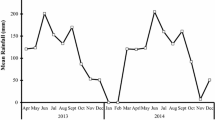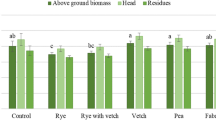Abstract
Green leaf manuring with prunings of Leucaena leucocephala is regarded as a useful source of N to plants but the actual substitution of N fertilizer, release and recovery of N as well as effects on soil fertility are not adequately studied. The present studies investigated the effect of sole and combined use of Leucaena prunings and urea N fertilizer in different proportions on productivity, profitability, N uptake and balance in maize (Zea mays)–wheat (Triticum aestivum) cropping system at New Delhi during 2002–2003 and 2003–2004. Varying quantities of Leucaena green leaf biomass containing 3.83–4.25% N (18.2–20.5 C:N ratio) were applied to provide 0, 25, 50, 75 and 100% of recommended N (120 kg ha−1) to both maize and wheat before sowing. In general, direct application of urea N increased the productivity of both crops more than Leucaena green leaf manure, but the reverse was true for the residual effect of these sources. The productivity of maize increased progressively with increasing proportions of N through urea fertilizer and was 2.41–2.52 t ha−1 with 60 kg N ha−1 each applied through Leucaena and urea, which was at par with that obtained with 120 kg N ha−1 through urea alone (2.56–2.74 t ha−1). Similarly, wheat yield was also near maximum (4.46–5.11 t ha−1) when equal amounts of N were substituted through Leucaena and urea. Residual effects were obtained on the following crops and were significant when greater quantity of N (>50%) was substituted through Leucaena. Nitrogen uptake and recovery were also maximum with urea N alone, and N recovery was higher in maize (33.4–42.1%) than in wheat (27.3–29.8%). However, recovery of residual N in the following crop was more from Leucaena N alone (8.5–10.3%) than from urea fertilizer (1.7–3.8%). Residual soil fertility in terms of organic C and KMnO4 oxidizable N showed improvement with addition of Leucaena prunings, which led to a positive N balance at the end of second cropping cycle. Net returns were considerably higher with wheat than with maize, and were comparatively lower with greater proportion of Leucaena because of its higher cost. Nonetheless, it was beneficial to apply Leucaena and urea on equal N basis for higher productivity and sustainability of this cereal-based cropping system.

Similar content being viewed by others
References
Akkinifesi FK, Kang BT, Sanginga N, Tijani-Eniola H (1996) Nitrogen use efficiency and N-competition between Leucaena hedge rows and maize in an alley cropping system. Nutr Cycl Agroecosyst 47(1):71–80. doi:10.1007/BF01985720
Buresh RJ, De Datta SK (1991) Nitrogen dynamics and management in rice–legume cropping systems. Adv Agron 45:1–59. doi:10.1016/S0065-2113(08)60037-1
Guevarra AB (1976) Management of Leucaena leucocephala for maximum yield and nitrogen contribution to intercropped corn. PhD thesis, University of Hawai
Jones RB, Wendt JW, Bunderson WT, Itimu OA (1996) Leucaena + maize alley cropping in Malawi Part 1: effects of N, P and leaf application on maize yields and soil properties. Agrofor Syst 33(3):281–294. doi:10.1007/BF00055428
Kang BT, Grimme H, Lawson TL (1985) Alley cropping sequentially cropped maize and cowpea with Leucaena on a sandy soil in southern Nigeria. Plant Soil 85:267–277. doi:10.1007/BF02139631
Karachi M (1998) Variation in the nutritional value of leaf and stem fractions in nineteen Leucaena lines. Anim Feed Sci Technol 70:305. doi:10.1016/S0377-8401(97)00117-X
Ladha JK, Pathak H, Krupnik TJ, Six J, van Kessel C (2005) Efficiency of fertilizer nitrogen in cereal production: retrospects and prospects. Adv Agron 87:85–143. doi:10.1016/S0065-2113(05)87003-8
Lehria SK, Bali SV, Singh B (2006) Effect of green leaf manure of subabul (Leucaena leucocephala Lam. De Wit) on maize crop and its residual effect on wheat crop. In: Verma KS, Khurana DK, Christersson L (eds) Proceedings of the IUFRO-ISTS-UHF International Conference on World Perspective on Short Rotation Forestry for Industrial and Rural Development, Nauni, Solan, India, pp 316–319
Mafongoya PL, Mugendi DN, Pendreira CGS (1997) Evaluation of Leucaena leucocephala leaf prunings as a source of nitrogen for maize. Afr Crop Sci J 5(2):249–255
Mittal SP, Grewal SS, Agnihotri Y, Sud AD (1992) Substitution of nitrogen requirement of maize through leaf biomass of Leucaena leucocephala: agronomic and economic considerations. Agrofor Syst 19(3):207–216. doi:10.1007/BF00118778
Mugendi DN, Nair PKR, Mugwe JN, O’Neill MK, Swift MJ, Woomer PL (1999) Alley cropping of maize with Calliandra and Leucaena in the subhumid highlands of Kenya Part 2 Biomass decomposition, N mineralization, and N uptake by maize. Agrofor Syst 46(1):51–64. doi:10.1023/A:1006269217882
Mulongoy K, van der Meersch MK (1988) Nitrogen contribution by Leucaena (Leucaena leucocephala) prunings to maize in an alley cropping system. Biol Fertil Soils 6(4):282–285. doi:10.1007/BF00261013
Mureithi JG, Tayler RS, Thorpe W (1994) The effects of Leucaena leucocephala and of different management practices on the productivity of maize and soil chemical properties in lowland coastal Kenya. Agofor Sys 27(1):31–51. doi:10.1007/BF00704833
Nambiar KKM (1998) Soil fertility and crop productivity under long-term fertilizer use in India. Indian Council of Agricultural Research, New Delhi, p 144
Nanda SS, Bishoyi BS, Alim MA (2002) Management of nitrogen with and without organic manures in forage maize–wheat sequence. Environ Ecol 20(3):656–660
Palled YB, Desai BK, Prabhakar AS (2000) Integrated nutrient management in alley cropped maize (Zea mays)–groundnut (Arachis hypogaea) system with subabul (Leucaena leucocephala). Indian J Agron 45(3):520–525
Pandey CB, Pandya KS, Singh GR, Sharma RB (1998) Effect of Leucaena leucocephala pruning on growth and productivity of maize (Zea mays) in an alley-cropping. Range Manag Agrofor 19(2):179–185
Prasad R (2005) Rice–wheat cropping systems. Adv Agron 86:255–339. doi:10.1016/S0065-2113(05)86006-7
Prasad R, Shivay YS, Kumar D, Sharma SN (2006) Learning by Doing Exercises in Soil Fertility, 68 p. Division of Agronomy. Indian Agricultural Research Institute, New Delhi
Shah Z, Ahmed MI (2006) Effect of integrated use of farmyard manure and urea on yield and nitrogen uptake of wheat. J Agric Biol Sci 1(1):60–65
Sharma AR, Behera UK (2004) Fertilizer use and options for diversification in rice–wheat cropping system in India. Fertil News 49(12):115–131
Sharma AR, Ghosh A (2000) Effect of green manuring with Sesbania aculeata and nitrogen fertilization on the performance of direct-seeded flood-prone lowland rice. Nutr Cycl Agroecosyst 57:141–153. doi:10.1023/A:1009863100224
Sharma AR, Singh R, Dhyani SK (2005) Conservation tillage and mulching for optimizing productivity in maize-wheat cropping system in the outer Himalayan region-a review. Indian J Soil Conserv 33(1):35–43
Singh Y, Singh B, Khind CS (1991) Efficient management of leguminous green manures in wetland rice. Adv Agron 45:135–189. doi:10.1016/S0065-2113(08)60040-1
Soltan SA, El-Ghandour IA, Abdel-Aziz HA (2001) Contribution of Leucaena prunings in providing nutrients to maize grown with Leucaena trees in an alley cropping system. Ann Agric Sci 39(3):1853–1864
Tesfaye E, Suwanarit A, Verasan V, Chanchareonsook J (2005) Influence of rates of application of different plant residues on time courses of N mineralization and immobilization in soils with different textures. Kasetsart J Nat Sci 39(4):601–611
Vanlauwe B, Sanginga N (1998) Recovery of Leucaena and Dactyladenia residue N15 in alley cropping systems. Soil Sci Soc Am J 62:454–460
Xu ZH, Myers RJK, Saffigna PG, Chapman AL (1993) Nitrogen cycling in Leucaena (Leucaena leucocephala) alley cropping in semi-arid tropics I. Mineralization of nitrogen from Leucaena residues. Plant Soil 148:63–72. doi:10.1007/BF02185385
Author information
Authors and Affiliations
Corresponding author
Rights and permissions
About this article
Cite this article
Sharma, A.R., Behera, U.K. Green leaf manuring with prunings of Leucaena leucocephala for nitrogen economy and improved productivity of maize (Zea mays)–wheat (Triticum aestivum) cropping system. Nutr Cycl Agroecosyst 86, 39–52 (2010). https://doi.org/10.1007/s10705-009-9272-9
Received:
Accepted:
Published:
Issue Date:
DOI: https://doi.org/10.1007/s10705-009-9272-9




